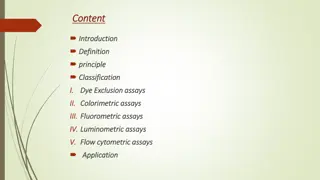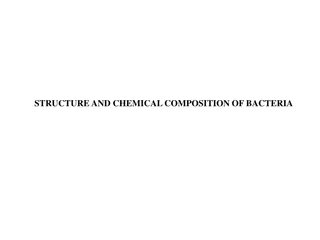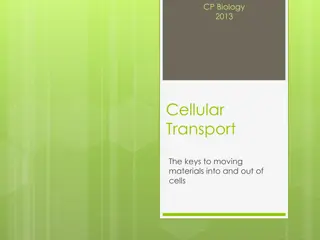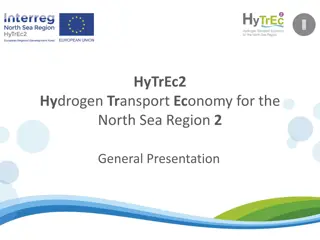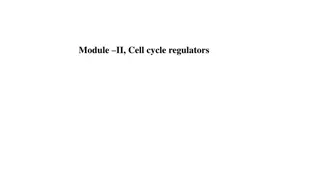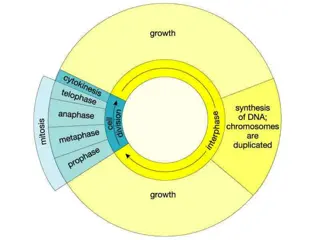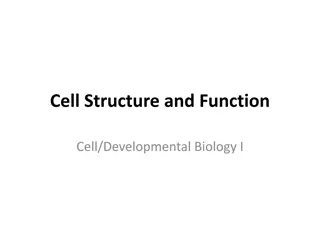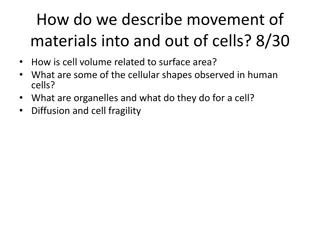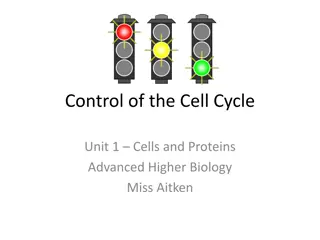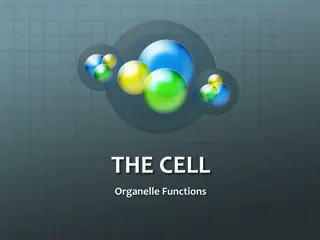
Understanding Cellular Transport Mechanisms
Learn about how your body maintains homeostasis through cellular transport. Explore the concepts of passive and active transport, diffusion, osmosis, and facilitated diffusion. Understand the role of the cell membrane in regulating the movement of substances in and out of cells for maintaining internal balance.
Download Presentation

Please find below an Image/Link to download the presentation.
The content on the website is provided AS IS for your information and personal use only. It may not be sold, licensed, or shared on other websites without obtaining consent from the author. If you encounter any issues during the download, it is possible that the publisher has removed the file from their server.
You are allowed to download the files provided on this website for personal or commercial use, subject to the condition that they are used lawfully. All files are the property of their respective owners.
The content on the website is provided AS IS for your information and personal use only. It may not be sold, licensed, or shared on other websites without obtaining consent from the author.
E N D
Presentation Transcript
Homeostasis The need of an organism to maintain and regulate constant or stable internal conditions. How does your body regulate (aka maintain homeostasis)? Temperature, pH, and the concentration of other materials and nutrients must be maintained within a relatively narrow margin. Much of homeostasis is maintained by the cell membrane controlling movement of things in and out of the cell
Cell Membrane The cell membrane is said to be selectively permeable, meaning certain substances can move across it freely, while others must move through a gate . Transport of materials can be classified as either passive transport or active transport.
Cellular Transport Passive Transport requires no extra energy by the cell because molecules move from high concentration (squished together) to low concentration (spread out) areas down the concentration gradient. Active Transport requires extra energy (ATP) to be spent to bring materials into the cell or expel materials out of the cell moving from low concentration to high concentration against the concentration gradient.
Examples of Transport Passive Transport Diffusion Osmosis Facilitated Diffusion Active Transport Molecular Pumps Exocytosis Endocytosis
Words to Know Solute what gets dissolved (Ex. Lemonade powder) Solvent does the dissolving (Ex. Water) Solution uniform mixture of two or more substances (Ex. Lemonade) Concentration amount of solute dissolved in solvent Symbol for abbreviation = [ ]
Passive Transport: Diffusion The spreading out of molecules across a membrane until they are equally concentrated on both sides of the membrane. Molecules move down a concentration gradient, from high [ ] to an area of low [ ] Ex. Oxygen and Carbon Dioxide Over time
Passive Transport: Facilitated Diffusion A transport protein acts as a protein channel to help (facilitate) the diffusion of molecules that normally couldn t pass through the cell membrane Molecules move down a concentration gradient, from high [ ] to an area of low [ ] Ex. Glucose/sugar, sodium/salt Over time
Passive Transport: Osmosis The diffusion of water across the cell membrane Water molecules move down a concentration gradient, from high [ ] to an area of low [ ] Over time
Passive Transport: Osmosis Hypertonic solutions: water concentration is below what is found in a cell s cytoplasm. Water will tend to move out of the cell, down its concentration gradient Cell shrivels Hypotonic solutions: water concentration is above what is found in a cell s cytoplasm. Water will tend to move into a cell, down its concentration gradient Cell swells Isotonic solutions: identical water concentrations to what is found in a cell s cytoplasm Cell stays the same
Passive Transport: Osmosis Hypotonic Hypertonic Isotonic H2O H2O H2O H2O H2O H2O Cell stays the same Cell shrivels Cell swells
Active Transport Remember not all substances can move so freely into a cell. Some molecules have to be pushed uphill, against a concentration gradient. This means substances are moving from an area of low [ ] to an area of high [ ] Other substances are too big to move through a protein channel, and have to be enveloped by the cell or excreted by the cell. This is accomplished by either endocytosis or exocytosis.
Active Transport: Molecular Pumps When a cell uses energy to pump molecules across the membrane through a protein channel. This allows a cell to concentrate key molecules within the cell, or remove waste quickly from the cell. Ex. Calcium (Ca2+), potassium (K+), chlorine (Cl-) and sodium (Na+) = ions (charged particles) ENERGY Over time
Active Transport: Endocytosis Acell uses energy to import large amounts of materialsINTO the cell using a vesicle Ex. White blood cells engulf bacteria to fight infection
Active Transport: Exocytosis Acell uses energy to exportlarge amounts of materialsOUT OF the cell using a vesicle Ex. Nerve cells release neurotransmitters to pass signals to the brain
Practice Time! Passive/Acti ve being moved Type of Transport Ex. of what is How it helps maintain homeostasis Facilitated Diffusion Regulates blood sugar Active Neurotransmitters Endocytosis Captures bacteria Passive Controls blood pressure by regulating blood volume Passive O2 and CO2 K+, Na+, Ca2+, Cl- Muscle contractions and nerve signal conduction


